Yesterday afternoon, on European Antibiotic Awareness Day, we joined the Royal Society of Chemistry (RSC) at Burlington House in London, Piccadilly for a foray into antimicrobial research.
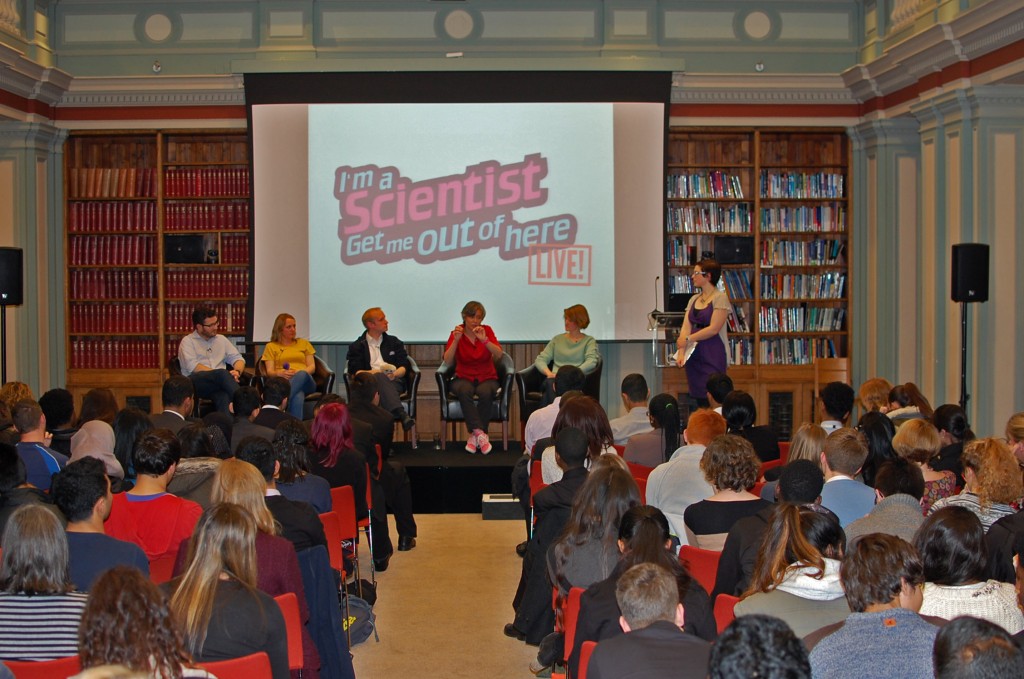
I’m a Scientist: Live at Burlington House.
We took five scientists — three of whom were I’m a Scientist alumni, having taken part in previous online events — whose research looks at the uses of antibiotics and antimicrobials, put them in a room in-front of around 100 sixth-formers, and had them answer questions on everything from Typhoid Mary, to zombie apocalypses.
Our scientists were Rob Shorten, Jess Bean, Mark Roberts, Clare Taylor, and Emma Newton.
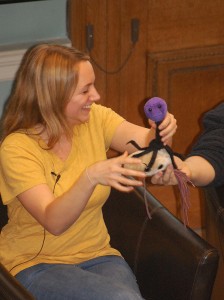
Jess Bean and Mark Roberts go for the BAFTA puppeteering award with plush microbes.
Helen Arney, our MC for the afternoon kicked off by introducing the scientists before launching into a round of Science Fact or Fiction. The facts covered everything from bacteria flavouring cheese and yogurt, to our being only 10% human, with most of the cells in the body (by number) actually being bacteria. Clare introduced the notion that around 3% of the population can carry Salmonella their whole lives without ever becoming ill; setting up a whole round of questions on historical poisoning and Typhoid Mary.
We then moved on to the questions round: Emma presented a world first, showing us her “electronic nose”, a prototype device for sniffing out different bacteria based on the chemicals they produce. Using plush microbes, Jess and Mark acted out an Academy Award worthy demonstration of a bacteriophage’s attack on an E coli cell. Rob took us through the purposes of a faecal transplant, Mark explained how some bacteria can follow the earth’s magnetic field, while Clare took the audience award to the best piece of advice for surviving a microbial zombie outbreak: “there’s always a percentage of the population with a resistance; seek them out and make a cure.”
In the end there could only be one winner. After giving the scientists a last plea for votes the votes were counted yielding a surprisingly close spread, with Clare standing above the others to take hold the coveted I’m a Scientist: Live trophy and mug.
Let’s evaluate
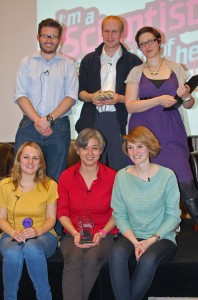
Standard end of event competitors’ photo, accompanied by MC, Helen Arney.
The room was filled, with around 100 students in their seats, votes being counted using the electronic voting system were all around the 90 mark. The audience was made up predominantly of school students, with about 12% being teachers.
The use of electronic voting pads gave us the chance to do some on-the-spot evaluation of how the audience found the event. A majority of the audience who provided this feedback said they had learnt something with 49% saying they had “learnt a lot”, and 37% learning “a bit”; only 8 respondents (14%) said they had not learnt anything.
To the question, “Has the show made you want to find out more about antimicrobials?”, 50% of those who replied “got the bug”, while 18% had had enough. Owing to a slight technical fault we weren’t able to count the replies to, “Did you enjoy the show?”, what we did get were a whole lot of positive comments from students and teachers.
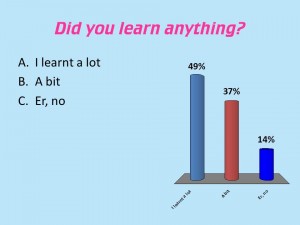
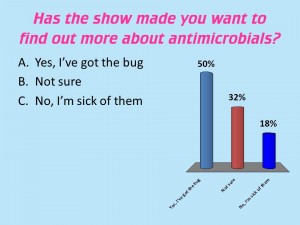
Really informative; loved the bit when the scientists talked about their specialties; really interactive – the pads were great; great venue and they liked the refreshments (felt very adult!)
Many students stayed behind to ask more questions to the scientists once the event was over, and working by the buzz in the room, and the comments from teachers and students, it seems like the afternoon was a resounding success.
What have we learnt?
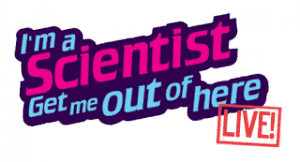
- Scientists bringing props is a good thing.
- Being nice and altruistic can get you lots of votes, or certainly lots of applause.
- It’s useful to run through the technical aspects of the event maybe a couple more times than might feel necessary; can’t be too prepared.
- Students appreciate when a refreshment buffet includes cake.
Recent Comments
No comments to display